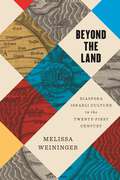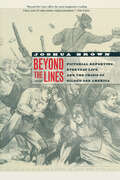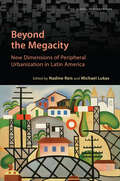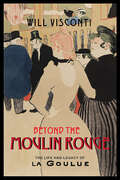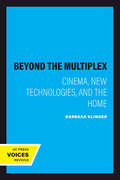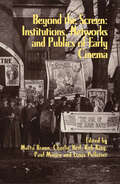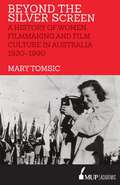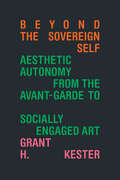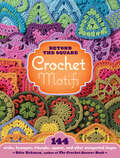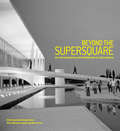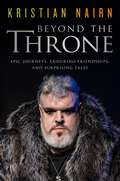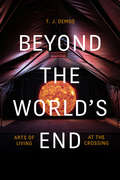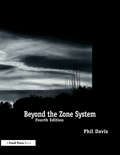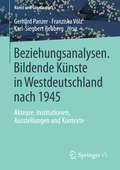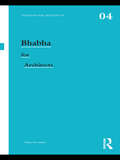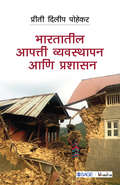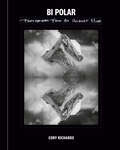- Table View
- List View
Beyond the Land: Diaspora Israeli Culture in the Twenty-First Century
by Melissa WeiningerThis thought-provoking exploration of literature and art examines contemporary Israeli works created in and about diaspora that exemplify new ways of envisioning a Jewish national identity. Diaspora has become a popular mechanism to imagine non-sovereign models of Jewish peoplehood, but these models often valorize powerlessness in sometimes troubling ways. In this book, Melissa Weininger theorizes a new category of "diaspora Israeli culture" that is formed around and through notions of homeland and complicate the binary between diaspora and Israel. The works addressed here inhabit and imagine diaspora from the vantage point of the putative homeland, engaging both diasporic and Zionist models simultaneously through language, geography, and imagination. These examples contend with the existence of the state of Israel and its complex implications for diaspora Jewish identities and nationalisms, as well as the implications for Zionism of those diasporic conceptions of Jewish national identity. This dynamic understanding of both an Israeli and a Jewish diaspora works to envision a non-hegemonic Jewish nationalism that can negotiate both political imagination and reality.
Beyond the Lines: Pictorial Reporting, Everyday Life, and the Crisis of Gilded Age America
by Joshua BrownIn this wonderfully illustrated book, Joshua Brown shows that the wood engravings in the illustrated newspapers of Gilded Age America were more than a quaint predecessor to our own sophisticated media. As he tells the history and traces the influence of Frank Leslie's Illustrated Newspaper, with relevant asides to Harper's Weekly, the New York Daily Graphic, and others, Brown recaptures the complexity and richness of pictorial reporting. He finds these images to be significant barometers for gauging how the general public perceived pivotal events and crises—the Civil War, Reconstruction, important labor battles, and more. This book is the best available source on the pictorial riches of Frank Leslie's newspaper and the only study to situate these images fully within the social context of Gilded Age America. Beyond the Lines illuminates the role of illustration in nineteenth-century America and gives us a new look at how the social milieu shaped the practice of illustrated journalism and was in turn shaped by it.
Beyond the Megacity: New Dimensions of Peripheral Urbanization in Latin America (Global Suburbanisms)
by Nadine Reis Michael LukasBeyond the Megacity connects and reconnects the global debate on the contemporary urban condition to the Latin American tradition of seeing, considering, and theorizing urbanization from the margins. It develops the approach of "peripheral urbanization" as a way to integrate the theoretical agendas belonging to global suburbanisms, neo-Marxist accounts of planetary urbanization, and postcolonial urban studies, and to move urban theory closer to the complexity and diversity of urbanization in the Global South. From an interdisciplinary perspective, Beyond the Megacity investigates the natures, causes, implications, and politics of current urbanization processes in Latin America. The book draws on case studies from various countries across the region, covering theoretical and disciplinary approaches from the fields of geography, anthropology, sociology, urban studies, agrarian studies, and urban and regional planning, and is written by academics, journalists, practitioners, and scholar-activists. Beyond the Megacity unites these unique perspectives by shifting attention to the places, processes, practices, and bodies of knowledge that have often been neglected in the past.
Beyond the Moulin Rouge: The Life and Legacy of La Goulue (Peculiar Bodies)
by Will ViscontiBest known by her stage name, La Goulue (the Glutton), Louise Weber was one of the biggest stars of fin de siècle Paris, renowned as a cancan dancer at the Moulin Rouge. The subject of numerous paintings and photographs, she became an iconic figure of modern art. Her life, however, has consistently been misrepresented and reduced to a footnote in the stories of men such as Henri de Toulouse-Lautrec. Where most accounts dismiss her rise and fall as brief and rapid, the truth is that her career as a performer spanned five decades, during which La Goulue constantly reinvented herself—as a dancer, animal tamer, sideshow performer, and muse of photographers, painters, sculptors, and filmmakers.With Beyond the Moulin Rouge, the first substantive English-language study of La Goulue’s career and posthumous influence, Will Visconti corrects persistent myths. Despite a tumultuous personal life, La Goulue overcame loss, abusive relationships, and poverty to become the very embodiment of nineteenth-century Paris, fêted by royalty and followed as closely as any politician or monarch.Visconti draws on previously overlooked materials, including medical records, media reports across Europe and the United States, and surviving pages from Louise Weber’s diary, to trace the life and impact of a woman whose cultural significance has been ignored in favor of the men around her, and who spent her life upending assumptions about gender, morality, and domesticity in France during the fin de siècle and early twentieth century.Peculiar Bodies: Stories and Histories
Beyond the Movie Theater: Sites, Sponsors, Uses, Audiences
by Gregory A. WallerA free ebook version of this title is available through Luminos, University of California Press's Open Access publishing program. Visit www.luminosoa.org to learn more.Beyond the Movie Theater excavates the history of non-theatrical cinema before 1920, exploring where and how moving pictures of the 1910s were used in ways distinct from and often alternative to typical theatrical cinema. Unlike commercial cinema, non-theatrical cinema was multi-purpose in its uses and multi-sited in where it could be shown, targeted at particular audiences and, in some manner, sponsored. Relying on contemporary print sources and ephemera of the era to articulate how non-theatrical cinema was practiced and understood in the US during the 1910s, historian Gregory A. Waller charts a heterogeneous, fragmentary, and rich field that cannot be explained in terms of a master narrative concerning origin or institutionalization, progress or decline. Uncovering how and where films were put to use beyond the movie theater, this book complicates and expands our understanding of the history of American cinema, underscoring the myriad roles and everyday presence of moving pictures during the early twentieth century.
Beyond the Multiplex: Cinema, New Technologies, and the Home
by Barbara KlingerSince the mid-eighties, more audiences have been watching Hollywood movies at home than at movie theaters, yet little is known about just how viewers experience film outside of the multiplex. This is the first full-length study of how contemporary entertainment technologies and media—from cable television and VHS to DVD and the Internet—shape our encounters with the movies and affect the aesthetic, cultural, and ideological definitions of cinema. Barbara Klinger explores topics such as home theater, film collecting, classic Hollywood movie reruns, repeat viewings, and Internet film parodies, providing a multifaceted view of the presentation and reception of films in U.S. households. Balancing industry history with theoretical and cultural analysis, she finds that today cinema's powerful social presence cannot be fully grasped without considering its prolific recycling in post-theatrical venues—especially the home.
Beyond the Screen: Institutions, Networks, and Publics of Early Cinema
by Marta Braun, Charlie Keil, Rob King, Paul Moore and Louis PelletierThis scholarly anthology presents a new framework for understanding early cinema through its usage outside the realm of entertainment.From its earliest origins until the beginning of the twentieth century, cinema provided widespread access to remote parts of the globe and immediate reports on important events. Reaching beyond the nickelodeon theatres, cinema became part of numerous institutions, from churches and schools to department stores and charitable organizations.Then, in 1915, the Supreme Court declared moviemaking a “busines, pure and simple,” entrenching the film industry’s role as a producer of “harmless entertainment.” In Beyond the Screen, contributors shed light on how pre-1915 cinema defined itself through institutional interconnections and publics interested in science, education, religious uplift, labor organizing, and more.
Beyond the Selfie: The Art of Self Portraiture in the Digital Age
by Rosie HardyDo you want to elevate your portraits beyond the tired old selfie?From Instagram sensation Rosie Hardy, this is the ultimate guide to photographic self-expression. Drawing on both her unique skills and lived experience, Rosie delivers a masterclass in self-portraiture, giving the reader the knowledge base and inspiration to tell their own stories, control their image and go far beyond the standard 'selfie'.Learn how to upgrade your photography skills and express yourself in meaningful and captivating ways with this invaluable guide. Ideal for both beginners and professionals, discover essential tips and advice on shooting, editing and personal confidence. Rosie lays out all the ingredients necessary for creating captivating self portraiture, presenting a recipe book for those hungry for self expression.
Beyond the Selfie: The Art of Self Portraiture in the Digital Age
by Rosie HardyDo you want to elevate your portraits beyond the tired old selfie?From Instagram sensation Rosie Hardy, this is the ultimate guide to photographic self-expression. Drawing on both her unique skills and lived experience, Rosie delivers a masterclass in self-portraiture, giving the reader the knowledge base and inspiration to tell their own stories, control their image and go far beyond the standard 'selfie'.Learn how to upgrade your photography skills and express yourself in meaningful and captivating ways with this invaluable guide. Ideal for both beginners and professionals, discover essential tips and advice on shooting, editing and personal confidence. Rosie lays out all the ingredients necessary for creating captivating self portraiture, presenting a recipe book for those hungry for self expression.
Beyond the Silver Screen: A History of Women, Filmmaking and Film Culture in Australia 1920–1990
by Mary TomsicBeyond the Silver Screen tells the history of women's engagement with filmmaking and film culture in twentieth-century Australia. In doing so, it explores an array of often hidden ways women in Australia have creatively worked with film. Beyond the Silver Screen examines film in a broad sense, considering feature filmmaking alongside government documentaries and political films. It also focusses on women's work regulating films and supporting film culture through organising film societies and workshops to encourage female filmmakers. As such, it tells a new narrative of Australian film history. Beyond the Silver Screen reveals the variety of roles film has in Australian society. It presents film as a medium of creative and political expression, which women have engaged with in diverse ways throughout the twentieth century. Gender roles and gendered ideologies operating within society at large have influenced women's opportunities to work with film and how their filmwork is recognised. Beyond the Silver Screen shows women's sustained involvement with film is best understood as political and cultural action.
Beyond the Sovereign Self: Aesthetic Autonomy from the Avant-Garde to Socially Engaged Art
by Grant H. KesterIn Beyond the Sovereign Self Grant H. Kester continues the critique of aesthetic autonomy begun in The Sovereign Self, showing how socially engaged art provides an alternative aesthetic with greater possibilities for critical practice. Instead of grounding art in its distance from the social, Kester shows how socially engaged art, developed in conjunction with forms of social or political resistance, encourages the creative capacity required for collective political transformation. Among others, Kester analyzes the work of conceptual artist Adrian Piper, experimental practices associated with the escrache tradition in Argentina, and indigenous Canadian artists such as Nadia Myre and Michèle Taïna Audette, showing how socially engaged art catalyzes forms of resistance that operate beyond the institutional art world. From the Americas and Europe to Iran and South Africa, Kester presents a historical genealogy of recent engaged art practices rooted in a deep history of cultural production, beginning with nineteenth-century political struggles and continuing into contemporary anticolonial resistance and other social movements.
Beyond the Square Crochet Motifs: 144 circles, hexagons, triangles, squares, and other unexpected shapes
by Edie EckmanMove beyond granny squares and get ready for crocheted circles, triangles, hexagons, and stars. Edie Eckman opens up the door to crocheting creativity with more than 140 motifs of every shape and size. Embellish your clothing, linens, housewares, and bags with colorful patterns as you put odd yarn leftovers to good use. Step-by-step instructions and color photographs provide the building blocks to limitless possibilities.
Beyond the Supersquare: Art and Architecture in Latin America after Modernism
by Antonio Sergio BessaBeyond the Supersquare: Art and Architecture in Latin America after Modernism, which developed from a symposium presented by the Bronx Museum of the Arts in 2011, showcases original essays by distinguished Latin American architects, historians, and curators whose research examines architecture and urban designpractices in the region during a significant period of the twentieth century. Drawing from the exuberant architectural projects of the 1940s to the 1960s, as well as from critically engaged artistic practices of the present day, the essays in this collection reveal how the heroic visions and utopian ideals popular in architectural discourse during the modernist era bore complicated legacies for Latin America—the consequences of which are evident in the vastly uneven economic conditions and socially disparate societies found throughout the region today.The innovative contributions in this volume address how the modernist movement came into being in Latin America and compellingly explore how it continues to resonate in today’s cultural discourse. Beyond the Supersquare takes themes traditionally examined within the strict field of urbanism and architecture and explores them against a broader range of disciplines, including the global economy, political science, gender, visual arts, philosophy, and urban planning.Containing a breadth of scholarship, this book offers a compelling and distinctive view of contemporary life in Latin America. Among the topics explored are the circulation of national cultural identities through architectural media, the intersection of contemporary art and urban social politics, and the recovery of canonically overlooked figures in art and architectural histories, such as Lina Bo Bardi and Joao Filgueiras Lima (“Lele”) from Brazil, Juan Legarreta of Mexico, and Henry Klumb in Puerto Rico.
Beyond the Teacup: 18th Century Sino-British Tea Trade and Design Cultural Exchange
by Chi ZhangThis book focuses on tea-ware design exchanges between China and the UK since the middle of 17th Century, and explores how design encouraged trade and how the market demand influenced the development of design. The spirit of Chinese tea came to Britain alone with tea itself, and enriched the design of tea-ware, as well as British tea culture. During this process, tea-related oriental aesthetics evolved into an aesthetic image mechanism and developed as aesthetic concept, which infiltrated from private space to social space.
Beyond the Tee: 9 Extraordinary Designs
by Mary Cannizzaro Jen Cannizzaro&“An exciting intro to the craft of making quilts using fabric from T-shirts . . . This how-to will be a boon to any quilter looking for a new challenge.&” —Publishers Weekly Expand your idea of what a T-shirt quilt can be! Create nine innovative projects from T-shirts, clothing solids, prints, motifs, onesies, ties—anything goes. Learn how to cut into clothing and maximize your fabric, even altering a design to fit special tees. Solve common challenges like motifs separated by zippers and logos that are too big or too small. With a few T-shirt quilt basics under your belt, and the designs and tips in this guide, you&’ll soon become an expert at preserving the past.
Beyond the Throne: Epic Journeys, Enduring Friendships, and Surprising Tales
by Kristian NairnBeyond the Throne is the first memoir to share behind‑the‑scenes stories of the perils and triumphs of Game of Thrones—from beloved performer Kristian Nairn, who played Hodor and became one of the most recognizable figures of the global television phenomenon.The story of an unlikely hero who fulfilled his destiny… Fans will be fascinated by Kristian Nairn&’s experience on Game of Thrones, from his unlikely audition to his on-the-job training as an actor to his ascendance as one of the most beloved and pivotal characters on the show. Nairn details the camaraderie that develops as the actors face the elements on set, not entirely unlike the ones their characters must endure on screen, as well as the life-altering effects of worldwide stardom. Nairn&’s personal story—raised by a single mother during the Troubles in Ireland, coming of age as a gay man in Lisburn and Belfast, navigating intolerance, and seeking out his scene—is an epic, often rollicking, sometimes heartbreaking journey all its own. Nairn finds his voice and his confidence performing as a drag queen called Revvlon, and eventually DJing at the legendary nightclub Kremlin. Through the pitfalls and revelations of his creative pursuits, Nairn comes to understand who he really is, and that he is enough—a message that will resonate for anyone who has struggled to find their place.
Beyond the Throne: Epic journeys, enduring friendships and surprising tales
by Kristian NairnBeyond the Throne is the first memoir to share behind‑the‑scenes stories of the perils and triumphs of Game of Thrones from beloved performer Kristian Nairn, who played Hodor and became one of the most recognizable figures of the global television phenomenon.The story of an unlikely hero who fulfilled his destiny...Fans will be fascinated by Kristian Nairn's experience on Game of Thrones, from his unlikely audition to his on-the-job training as an actor to his ascendance as one of the most beloved and pivotal characters on the show. Nairn details the camaraderie that develops as the actors face the elements on set, not entirely unlike the ones their characters must endure on screen, as well as the life-altering effects of worldwide stardom.Nairn's personal story-raised by a single mother during the Troubles in Ireland, coming of age as a gay man in Lisburn and Belfast, navigating intolerance, and seeking out his scene-is an epic, often rollicking, sometimes heart-breaking journey. Nairn finds his voice and his confidence performing as a drag queen called Revvlon, and eventually DJing at the legendary nightclub Kremlin. Through the pitfalls and revelations of his creative pursuits, Nairn comes to understand who he really is, and that he is enough-a message that will resonate for anyone who has struggled to find their place.
Beyond the World's End: Arts of Living at the Crossing
by T. J. DemosIn Beyond the World's End T. J. Demos explores cultural practices that provide radical propositions for living in a world beset by environmental and political crises. Rethinking relationships between aesthetics and an expanded political ecology that foregrounds just futurity, Demos examines how contemporary artists are diversely addressing urgent themes, including John Akomfrah's cinematic entanglements of racial capitalism with current environmental threats, the visual politics of climate refugees in work by Forensic Architecture and Teddy Cruz and Fonna Forman, and moving images of Afrofuturist climate justice in projects by Arthur Jafa and Martine Syms. Demos considers video and mixed-media art that responds to resource extraction in works by Angela Melitopoulos, Allora & Calzadilla, and Ursula Biemann, as well as the multispecies ecologies of Terike Haapoja and Public Studio. Throughout Demos contends that contemporary intersections of aesthetics and politics, as exemplified in the Standing Rock #NoDAPL campaign and the Zad's autonomous zone in France, are creating the imaginaries that will be crucial to building a socially just and flourishing future.
Beyond the Zone System
by Phil DavisThis fourth edition of Beyond the Zone System makes the science of photographic sensitometry both accessible and useful to interested photographers. It will appeal to any serious photographer interested in knowing how the materials and processes of black-and-white photography work. Instead of describing rote procedures to be followed blindly, this book provides the basis for understanding what needs to be done and why. This book relates theory to practice in a way that promotes a true partnership of science and art. Beyond the Zone System bridges the gap between the more theoretical aspects of the photographic process and the popular empirical procedures used by many photographers in the attempt to predict and control the quality of their photographs in practice.This book is intended primarily for photographers who use large-format cameras and black-and-white sheet film, but the basic information about how the B&W photographic materials and processes work will be useful to users of any B&W film format.Beyond the Zone System, 4th ed. will appeal to any serious photographer interested in knowing how the materials and processes of black-and-white photography work. Instead of describing rote procedures to be followed blindly, this book provides the basis for understanding what needs to be done and why. This book relates theory to practice in a way that promotes a true partnership of science and art.
Beziehungsanalysen. Bildende Künste in Westdeutschland nach 1945: Akteure, Institutionen, Ausstellungen und Kontexte (Kunst und Gesellschaft)
by Gerhard Panzer Franziska Völz Karl-Siegbert RehbergAb den fünfziger Jahren entstand in Westdeutschland mit der neu geschaffenen ,,documenta" allmählich das Bild einer eigenständigen ,,Westkunst". Unter neuen politischen Rahmenbedingungen bewegte sich die Kunstwelt zwischen Versuchen, an Vorkriegstraditionen anzuknüpfen und sich zu modernisieren. Es kanonisierten sich abstrakte Gegenwartstendenzen, welche in der Gegensatzspannung zum Osten zunehmend politisch instrumentalisiert wurden. Von den Zeitgenossen schon kontrovers diskutiert, wird diese Phase der Kunstentwicklung bis heute unterschiedlich bewertet. Der vorliegende Band versammelt historisch-empirische Analysen, die die Beziehungsgeflechte in der damaligen Kunstwelt und deren strukturbildende, dynamische Vernetzung mit der Gesellschaft untersuchen, wobei die sozialen Träger dieser Erfolgsgeschichte im Mittelpunkt stehen.
Bhabha for Architects (Thinkers for Architects)
by Felipe HernandezThe work of Homi K. Bhabha has permeated into numerous publications which use postcolonial discourse as a means to analyze architectural practices in previously colonized contexts, particularly in Africa, Asia, the Middle-East, South-East Asia and, Latin America. Bhabha's use of the concept of ‘space’ has made his work highly appealing to architects and architectural theorists. This introductory book, specifically for architects, focuses on Bhabha’s seminal book The Location of Culture and reveals how his work contributes to architectural theory and the study of contemporary architectures in general, not only in colonial and postcolonial contexts.
Bharata: The Natyasastra
by Kapila VatsyayanThe attempt has been to review the Natyasastra as an important confluence in the perennial flow of the tradition with the twin processes of continuity and change, as also of the interplay of the sastra and the prayoga, not to speak of the integral vision which provides a unity of purpose and rigorousness of structure to the text.
Bharatatil Aapatti Vyavasthapan va Prashasan
by Priti Diliprao PohekarDisaster Management is a critical and integral part of any government’s planning strategy. Indian government has been struggling with it since long. This book discusses the varied threats, risks that the country faces. It talks about the Acts implemented, their advantages/disadvantages and their validity. It also talks about the different stakeholders involved, role players and decision makers in the country. It compare country’s disaster management with international decisive moments and acts and the UN’s ordinance.
Bhutan
by John Berthold His Eminence Lyonpo Thinley GyamtshoRegarded as the "crown jewel of the Himalayas," the Kingdom of Bhutan is the last remaining independent country to support Buddhism as the official state religion. Photographed over the course of three years, Bhutan: Land of the Thunder Dragon transports us to colorful festivals and religious traditions, continuing to the remote communities along the roof of the world. This book encompasses a wide range of landscape, portrait, and editorial photographs sure to impress and please any reader interested in travel, photography, and/or Himalayan culture.
Bi-Polar: Photographs from an Unquiet Mind
by Cory RichardsThe debut photography collection from the internationally renowned photographer, filmmaker, speaker, and mental health advocate, featuring 300 curated images from his global adventure features, climbing expeditions, portraiture, and early fashion and fine art work.An artist and storyteller who passionately explores the human experience, Cory Richards began working for National Geographic shooting adventure features in the most remote corners of the globe. As a professional climber, he spent his early career on high-risk expeditions that tested his unique ability to capture stories that were largely out of reach to others. Bi-Polar, a title that refers to Richards&’s own diagnosis with Bipolar 2 at age fourteen and the career that has literally taken him to both ends of the earth, presents 300 of the most compelling images of Richards&’s career. Organized by the emotional polarities that exist in his life and work, including hope and fear, pride and shame, awe and contempt, and finally, the singular, love, this stunning visual collection is a celebration of the tempests of the mind and how our greatest hurdles, when seen through a different lens, can become our greatest strengths.Spotlighting jaw-dropping landscapes, disappearing ways of life, the intersection of humans and animals, and more, Bi-Polar invites us to consider how art can connect us to ourselves, others, and the beautiful world we live in.
